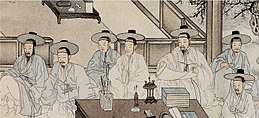Religion in Korea
Religion in Korea refers the various religious traditions practiced on the Korean peninsula. The oldest indigenous religion of Korea is the Korean folk religion, which has been passed down from prehistory to the present.[1] Buddhism was introduced to Korea from China during the Three Kingdoms era in the 4th century, and the religion flourished until the Joseon Dynasty, when Confucianism became the state religion.[2] During the Late Joseon Dynasty, in the 19th century, Christianity began to gain a foothold in Korea.[3] While both Christianity and Buddhism would play important roles in the resistance to the Japanese occupation of Korea in the first half of the 20th century,[4] only about 4% of Koreans were members of a religious organization in 1940.[5]
 |
| Part of a series on the |
| Culture of Korea |
|---|
| History |
|
Festivals |
|
|
Music and performing arts |
|
Media
|
|
|
Monuments
|
|
National symbols of Korea
|
Since the division of Korea into two sovereign states in 1945—North Korea and South Korea—religious life in the two countries has diverged, shaped by different political structures. Religion in South Korea has been characterized by a rise of Christianity and a revival of Buddhism, though the majority of South Koreans have no religious affiliation or follow folk religions.[6][7] Religion in North Korea is characterized by state atheism in which freedom of religion is nonexistent. Juche ideology, which promotes the North Korean cult of personality, is regarded by experts as a kind of national religion.[8]
References
- Yu (2012), p. 41.
- Encyclopaedia Britannica (2008), p. 162.
- Kim (2012).
- Yu (2012), p. xv.
- Baker, Don (2013). "Korea's Path of Secularisation". In Ghosh, Ranjan (ed.). Making Sense of the Secular: Critical Perspectives from Europe to Asia. Routledge. pp. 182–193. ISBN 978-1136277214.
- Baker, Donald L. (2008). Korean Spirituality. University of Hawaii Press. pp. 3–4. ISBN 978-0824832339.
- "성, 연령 및 종교별 인구 - 시군구" [Population by Gender, Age, and Religion - City/Country]. Korean Statistical Information Service (in Korean). 2015. Retrieved 2018-03-17.
- Annual Report of the United States Commission on International Religious Freedom (PDF). United States Commission on International Religious Freedom. 2017. p. 56.
Sources
- Encyclopaedia Britannica (2008). Encyclopedia of World Religions. Encyclopaedia Britannica Inc. ISBN 978-1593394912.
- Kim, Sebastian C. H.; Kim, Kirsteen (2014). A History of Korean Christianity. Cambridge: Cambridge University Press. ISBN 978-1316123140.CS1 maint: ref=harv (link)
- Yu, Chai-Shin (2012). The New History of Korean Civilization. iUniverse. ISBN 978-1462055593.CS1 maint: ref=harv (link)